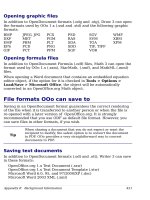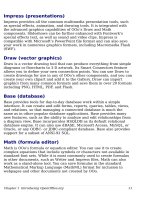Getting Started with Open Office .org 3 part 18 pps
Bạn đang xem bản rút gọn của tài liệu. Xem và tải ngay bản đầy đủ của tài liệu tại đây (4.77 MB, 10 trang )
What is Impress?
Impress is OpenOffice.org’s slide show (presentations) program. You
can create slides that contain many different elements, including text,
bulleted and numbered lists, tables, charts, clip art, and a wide range
of graphic objects. Impress also includes a spelling checker, a
thesaurus, prepackaged text styles, and attractive background styles.
This chapter includes instructions, screenshots, and hints to guide you
through the Impress environment while designing the easier
presentations. Although more difficult designs are mentioned
throughout this chapter, explanations for creating them are in the
Impress Guide
. If you have a working knowledge of how to create slide
shows, we recommend you use the
Impress Guide
for your source of
information.
To use Impress for more than very simple slide shows requires some
knowledge of the elements which the slides contain. Slides containing
text use styles to determine the appearance of that text. Slides
containing objects are created the same way that drawings are created
in Draw. For this reason, we recommend that you also study Chapter 3
(Working with Templates and Styles) and Chapter 7 (Getting Started
with Draw).
Parts of the main Impress window
The main Impress window (Figure 132) has three parts: the
Slides
pane
,
Workspace
, and
Tasks pane
. Additionally, several toolbars can be
displayed or hidden during the creation of a presentation.
Tip
You can remove the
Slides pane
or
Tasks pane
from view by
clicking the
X
in the upper right corner. You can also show or
hide these panes using View > Slide Pane or View > Tasks
Pane.
Slides pane
The
Slides pane
contains thumbnail pictures of the slides in your
presentation, in the order they will be shown (unless you change the
order). Clicking a slide selects it and places it in the
Workspace
. While
it is there, you can apply any changes desired to that particular slide.
Chapter 6 Getting Started with Impress 171
Figure 132: Main window of Impress
Several additional operations can be performed on one or more slides
in the Slides pane:
• Add new slides at any place within the presentation after the first
slide.
• Mark a slide as hidden so that it will not be shown as part of the
slide show.
• Delete a slide from the presentation if it is no longer needed.
• Rename a slide.
• Copy or move the contents of one slide to another (copy and
paste, or cut and paste, respectively).
It is also possible to perform the following operations, although there
are more efficient methods than using the Slides pane:
• Change the slide transition following the selected slide or after
each slide in a group of slides.
• Change the sequence of slides in the presentation.
• Change the slide design. (A window opens allowing you to load
your own design.)
• Change slide layout for a group of slides simultaneously. (This
requires using the
Layouts
section of the Tasks pane.)
172 Getting Started with OpenOffice.org 3
Tasks pane
The Tasks pane has five sections.
Master Pages
Here you define the page style for your presentation. Impress
contains 28 prepackaged Master Pages (slide masters). One of them
—Default—is blank, and the rest have a background.
Tip
Press
F11
to open the Styles and Formating window, where
you can modify the styles used in any slide master to suit your
purpose. This can be done at any time.
Layout
Twenty prepackaged layouts are shown. You can choose the one you
want, use it as it is or modify it to your own requirements. At
present it is not possible to create custom layouts.
Table Design
Eleven standard table styles are provided in this pane. You can
further modify the appearance of a table with the selections to show
or hide specific rows and columns, or to apply a banded appearance
to the rows and columns.
Custom Animation
A variety of animations for selected elements of a slide are listed.
Animation can be added to a slide, and it can also be changed or
removed later.
Slide Transition
Fifty-six transitions are available, including
No Transition
. You can
select the transition speed (slow, medium, fast). You can also choose
between an automatic or manual transition, and how long you want
the selected slide to be shown (automatic transition only).
Workspace
The
Workspace
has five tabs: Normal, Outline, Notes, Handout, and
Slide Sorter. These five tabs are called View buttons. There are also
many toolbars that can be used during slide creation; they are revealed
by selecting them with View > Toolbars. The
Workspace
is below the
View buttons. This is where you assemble the various parts of your
selected slide.
Chapter 6 Getting Started with Impress 173
Each view is designed to make completing certain tasks easier. In
summary:
•
Normal view
is the main view for creating individual slides. Use
this view to format and design slides and to add text, graphics,
and animation effects.
•
Outline view
shows topic titles, bulleted lists, and numbered lists
for each slide in outline format. Use this view to rearrange the
order of slides, edit titles and headings, rearrange the order of
items in a list, and add new slides.
•
Notes view
lets you add notes to each slide that are not seen
when the presentation is shown.
•
Slide Sorter view
shows a thumbnail of each slide in order. Use
this view to rearrange the order of slides, produce a timed slide
show, or add transitions between selected slides.
•
Handout view
lets you print your slides for a handout. You can
choose one, two, three, four, or six slides per page from Tasks
pane > Layouts. Thumbnails can be re-arranged in this view by
dragging and dropping them.
Toolbars
The various Impress toolbars can be displayed or hidden by clicking
View > Toolbars and selecting from the menu. You can also select the
icons that you wish to appear on each toolbar. For more information,
refer to Chapter 1 (Introducing OpenOffice.org).
Many of the toolbars in Impress are similar to the toolbars in OOo
Draw. Refer to the
Draw Guide
for details on the functions available
and how to use them.
Navigator
The Navigator (Figure 133) displays all objects contained in a
document. It provides another convenient way to move around a
document and find items in it. The Navigator icon is located on the
Standard toolbar. You can also display the Navigator by choosing Edit
> Navigator on the menu bar or pressing
Ctrl+Shift+F5
.
The Navigator is more useful if you give your slides and objects
(pictures, spreadsheets, and so on) meaningful names, instead of
leaving them as the default “Slide 1” and “Picture 1” shown in
Figure 133.
174 Getting Started with OpenOffice.org 3
Figure 133: Navigator
Working with views
This section describes the use of the five views.
Normal view
Normal view is the main view for working with individual slides. Use
this view to format and design and to add text, graphics, and animation
effects.
To place a slide in the Slide Design area of the Normal view, click the
slide thumbnail in the Slides pane or use the Navigator.
To select a slide in the Navigator, scroll down the list until you find it
and then double-click it.
Outline view
Outline view (Figure 134) contains all the slides of the presentation in
their numbered sequence. It shows topic titles, bulleted lists, and
numbered lists for each slide in outline format. Only the text contained
in the default text boxes in each slide is shown, so if your slide includes
other text boxes or drawing objects, the text in these objects is not
displayed. Slide names are also not included.
Chapter 6 Getting Started with Impress 175
Figure 134: Outline view
Outline view serves at least two purposes.
1) Making changes in the text of a slide:
• You can add and delete the text in a slide just as you would in
the Normal view.
• You can move the paragraphs of text in the selected slide up
or down by using the up and down arrow buttons (Move Up or
Move Down) on the Text Formatting toolbar.
• You can change the Outline Level for any of the paragraphs in
a slide using the left and right arrow buttons (Promote or
Demote).
• You can both move a paragraph and change its outline level
using a combination of these four arrow buttons.
2) Comparing the slides with your outline (if you have prepared one
in advance). If you notice from your outline that another slide is
needed, you can create it directly in the Outline view (pressing
Enter
when the cursor is on the first line of the slide) or you can
change to the Normal view to create it, then return to Outline
view to continue reviewing the slides against your outline.
If a slide is not in the correct sequence, you can move it to its
proper place.
a) In the slide pane, click the slide icon of the slide you are
moving.
b) Drag and drop it where you want it.
176 Getting Started with OpenOffice.org 3
Notes view
Use the Notes view to add notes to a slide.
1) Click the Notes tab in the Workspace (Figure 135).
2) Select the slide to which you want to add notes.
• Click the slide in the Slide pane, or
• Use the Previous Slide and Next Slide buttons to move to
the desired slide in the Navigator.
3) In the text box below the slide, click on the words
Click to add
notes
and begin typing.
You can resize the Notes text box using the green resizing handles and
move it by placing the pointer on the border, then clicking and
dragging. To make changes in the text style, press the
F11
key to open
the Styles and Formatting window.
Figure 135: Notes view
Chapter 6 Getting Started with Impress 177
Slide Sorter view
Slide Sorter view contains all the slide thumbnails (Figure 136). Use
this view to work with a group of slides or with only one slide.
Figure 136: Slide Sorter view
Change the number of slides per row if desired.
1) Check View > Toolbars > Slide View to make the Slide View
toolbar (Figure 137) visible.
Figure 137: Slide Sorter and Slide View toolbars
2) Adjust the number of slides (up to a maximum of 15).
3) When you have adjusted the number of slide per row, click View
> Toolbars > Slide View to remove this toolbar from view.
To move a slide in a presentation in the Slide Sorter:
1) Click the slide. A thick black border is drawn around it.
2) Drag and drop it to the location you want.
• As you move the slide, a black vertical line appears to one side
of the slide.
• Drag the slide until this black vertical line is located where
you want the slide to be moved.
178 Getting Started with OpenOffice.org 3
To select a group of slides, use one of these methods:
• Use the
Control
(
Ctrl
) key: Click on the first slide and, while
pressing Control, select the other desired slides.
• Use the
Shift
key: Click on the first slide, and while pressing the
Shift
key, click on the final slide in the group. This selects all of
the other slides in between the first and the last.
• Use the mouse cursor: Click on the first slide to be selected. Hold
down the left mouse button. Drag the cursor to the last slide
thumbnail. A dashed outline of a rectangle forms as you drag the
cursor through the slide thumbnails and a thick black border is
drawn around the selected slides. Make sure the rectangle
includes all the slides you want to select.
To move a group of slides:
1) Select the group.
2) Drag and drop the group to their new location. The same vertical
black line appears to show you where the group of slides will go.
Note
Selection of a group of slides works in a rectangular fashion.
Slides that do not fall within a rectangular area cannot be
grouped.
You can work with slides in the Slide Sorter view just as you can in the
Slide pane. To make changes, right-click a slide and do any of the
following using the pop-up menu:
• Add a new slide after the selected slide.
• Delete the selected slide.
• Change the slide layout.
• Change the slide transition.
• For one slide, click the slide to select it. Then add the desired
transition.
• For more than one slide, select the group of slides and add the
desired transition.
• Mark a slide as hidden. Hidden slides are not shown in the slide
show.
• Copy or cut and paste a slide.
Chapter 6 Getting Started with Impress 179
Handout view
Handout view is for setting up the layout of your slide for a printed
handout. Click the
Handout
tab in the workspace, then choose Layouts
in the Tasks pane. Layout contains five choices: 1, 2, 3, 4, 6, or 9 slides
per page (Figure 138).
Figure 138: Handout layouts
To print a handout:
1) Select the slides using the Slide Sorter. (Use the steps listed in
selecting a group of slides on page 179.)
2) Select File > Print or press
Control+P
to open the Print dialog.
3) Select Options in the bottom left corner. of the Print dialog.
4) Check Handouts in the
Contents
section, and then click OK.
5) Click OK to close the Print dialog.
Creating a new presentation
This section describes how to set up a new presentation. The settings
selected here are general: they apply to all the slides.
Planning a presentation
The first thing to do is to decide what you are going to do with the
presentation. For example, putting a group of digital photos together in
a presentation requires very little planning. However, using a
presentation to increase the knowledge of others about your topic
requires much more planning.
You need to ask and answer many questions before you begin creating
a presentation. If you are not acquainted with creating presentations,
the answers will be more general. Those who have created a variety of
presentations in the past will want to have more specific answers.
180 Getting Started with OpenOffice.org 3









